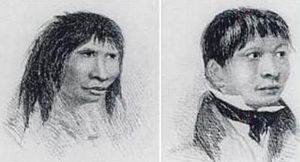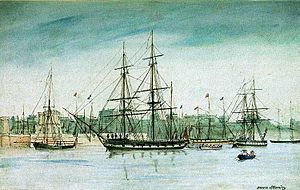Jemmy Button facts for kids
Orundellico, better known as "Jemmy Button" (around 1815–1864), was a young man from the Yaghan (or Yámana) group. They lived on islands near Tierra del Fuego, which is now part of Chile and Argentina.
Jemmy Button became famous for a while after he was taken to England by Captain FitzRoy on his ship, HMS Beagle.
Contents
Jemmy Button and the HMS Beagle
In 1830, Captain Robert FitzRoy was leading the first trip of the HMS Beagle. After one of his boats was taken, he brought some young Fuegian people aboard his ship.
Jemmy Button got his name because he was traded for a mother of pearl button. It's not fully clear if his family agreed to this trade or if he was simply taken.
Captain FitzRoy decided to bring four young Fuegians all the way to England. He hoped they would learn English and help create a friendly relationship between their people and the English. He cared for them well, feeding them before his own crew. He wanted them to get an education and learn about Christianity. This way, they could help improve life for their families back home.
The ship's crew gave English names to the Fuegians. They were York Minster, Jemmy Button, Fuegia Basket (a girl), and Boat Memory. Their original Yaghan names were El'leparu, O'run-del'lico, and Yok'cushly for the first three. Boat Memory's Yaghan name is not known. Sadly, Boat Memory died from smallpox soon after arriving in England.
Jemmy Button Arrives in England
The Beagle returned to Plymouth, England, in mid-October 1830. Newspapers quickly shared stories about the Yaghan visitors, and they became very famous.
In London, they even met King William IV. Queen Adelaide herself gave Fuegia Basket, the young girl, a special bonnet.
Returning Home to Patagonia
About a year later, Captain FitzRoy took the three surviving Fuegians back home. On this trip, he also brought a young naturalist named Charles Darwin. This was the second voyage of HMS Beagle.
At first, Jemmy had some trouble remembering his language and old ways. But soon, he took off his European clothes and went back to his traditional lifestyle. A few months after he returned, he was seen looking thin, wearing a loincloth, and with long hair.
Even so, he did not want to go back to England. Darwin thought this was because Jemmy had a "young and nice looking wife" in Tierra del Fuego. It seems that Jemmy and the others had taught some English to their families.
Darwin also wrote that Jemmy Button, like other Fuegians, did not have a concept of God or the Devil. Darwin suggested that Jemmy never really understood the plan to convert Fuegians to Christianity. He proudly said that there was "no devil in his land."
The Wulaia Bay Incident
In 1855, a group of Christian missionaries from the Patagonian Missionary Society visited Wulaia Bay on Navarino Island. They found that Jemmy could still speak English very well.
Some years later, in 1859, another group of missionaries was killed at Wulaia Bay by the Yaghan people. Some believed Jemmy and his family were involved. In early 1860, Jemmy visited Keppel Island and gave his side of the story at an investigation held in Stanley. He said he was not responsible for what happened.
Later Life and Death
In 1863, a missionary named Waite Stirling visited Tierra del Fuego. He reconnected with Jemmy, and after this, relations with the Yaghan people got better.
Jemmy Button died in 1864. In 1866, after Jemmy's death, Stirling took one of Jemmy's sons, known as Threeboy, to England.
See also
 In Spanish: Jemmy Button para niños
In Spanish: Jemmy Button para niños





